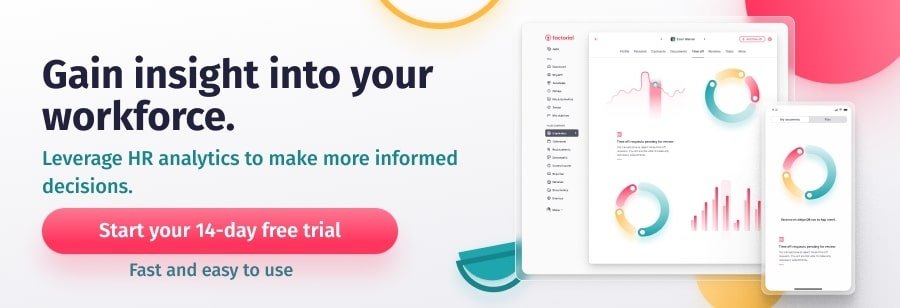Although presenteeism is a relatively new concept, it has been attracting increasing attention over the past few years. The biggest problem with presenteeism is that it can be difficult to identify and even harder to measure. An absence is easy to spot – an empty seat or a lack of productivity. But how do you know if you have a problem with presenteeism?
In this post, we will take a deep dive into presenteeism and absenteeism in the workplace. We will look at how you can measure presenteeism and what the cost could be for your company if you fail to address potential issues. We will also share a few best practices to help you reduce presenteeism in your business and build a happy, focused, and productive workforce.
Presenteeism Meaning
Let’s start with the basics: what is presenteeism?
Presenteeism occurs when employees go to work but they are not performing at full capacity for genuine, justifiable reasons. For example, productivity may be affected due to mental health issues, stress, tiredness, or minor health conditions such as allergies, arthritis, or migraines. The term does not relate to employees who are slacking or unproductive because they are purposefully avoiding work. It is a lack of productivity as a direct result of physical or mental health disorders.
Presenteeism is particularly prevalent in professions that experience a lot of stress or have heavy workloads, such as nursing. It is often an issue in businesses where there are high employer expectations, or there is demanding workplace culture. It is also more commonly found in companies that do not prioritise wellness and the employee experience.
Another related phenomenon that has arisen since the pandemic and subsequent shift to remote work is digital presenteeism. This is where workers feel under pressure to always be available online, via video calls, phone, email, chat, or Slack. This results in employee burnout in remote workers and a long-term decrease in productivity.
Now let’s take a look at the differences between presenteeism and absenteeism in the workplace.
Presenteeism and Absenteeism in the Workplace
Presenteeism and absenteeism in the workplace can both cause problems for employers. However, although both can result in a lack of productivity, they are actually two very different issues.
Employee absenteeism is defined as unplanned or unscheduled absences. In other words, when an employee fails to turn up for work. This might be due to personal or family emergencies, or short-term absences resulting from stress, burnout, injury, or ongoing illness. It does not include planned absences due to authorised annual or parental leave. All companies experience absenteeism to some degree as we are all human and occasionally need unplanned time away from work.
In contrast, presenteeism, as we saw above, is when an employee is at work, but they are not doing their job or being productive. This usually occurs as a result of a physical or mental health issue. For example, an employee may feel unwell but decide to come to work anyway. Or they might be tired or suffering from stress which has an effect on their motivation and productivity.
If you use time and attendance software then it is very easy to create and track metrics related to absenteeism. It is not so easy to track and monitor presenteeism as it is often difficult to spot, especially if an employee appears to be well on the surface. The best way to manage it is to put systems in place that preempt it, such as wellness initiatives and programs that support staff and nurture the employee experience. We also give you 13 tips to reduce employee stress in the workplace.
Measuring Presenteeism Rates with HR Metrics
Although it’s much harder to identify presenteeism than absenteeism, there are a few warning signs you should watch out for.
Employees are more likely to develop issues with presenteeism if they:
- Make a habit of coming to work even when they are sick.
- Play down health issues (physical or mental health).
- Often work long hours (beyond contracted hours).
- Regularly come in early and/or finish late.
- Find it hard to disconnect from work after the working day has ended (a big giveaway might be that they regularly send emails late at night).
If you suspect an employee might be at risk, then there is one key metric you can use to measure and track the impact of presenteeism on performance: the Stanford Presenteeism Scale. This is a short survey that can be used with any employee that has an ongoing physical or mental health issue that may be affecting their work.
The survey consists of 6 items, measured on a 5-point Likert scale. This scale ranges from “strongly disagree” to “strongly agree”:
- Because of my health problem, the stresses of my job were much harder to handle.
- Despite having my health problem, I was able to finish hard tasks in my work.
- My health problem distracted me from taking pleasure in my work.
- I felt hopeless about finishing certain work tasks, due to my health problem.
- At work, I was able to focus on achieving my goals despite my health problem.
- Despite having my health problem, I felt energetic enough to complete all my work.
At a more general level, you could also use Factorial’s workplace stress survey to gain insight into all members of your workforce and identify potential problem areas before they become an issue.
Cost of Presenteeism
If you fail to address it, presenteeism can have a negative effect on the health and well-being of your employees. What’s more, it can also be incredibly bad for business. It can affect your bottom line and even damage your company’s long-term reputation.
Specifically, presenteeism can:
- Make other employees sick by passing on germs and infections.
- Cause increased stress for both the employee in question and their colleagues if the drop in performance impacts their own workloads.
- Leading to burnout and long-term loss of productivity.
- Increase the chances of mistakes being made if an employee is not focused on the job.
- Lower employee morale and engagement levels.
- Increase staff turnover rates.
- Have a negative impact on reputation if the company is seen as demanding and unsupportive.
Presenteeism and Mental Health
Although physical health conditions can be a contributing factor (especially if you have employees with chronic health conditions), research shows that there is a strong link between absenteeism presenteeism and wellness. In other words, the mental health of your employees can be a clear indicator of your likelihood of experiencing presenteeism.
For this reason, many companies are now beginning to appreciate the benefits of investing in wellness initiatives and improving employee work-life balance. In fact, more than appreciating, employers are now realising that they have a responsibility to support employee mental health. Not just for the good of the health of their employees, but also because it has a direct impact on performance and productivity.
Aside from offering the right training and support, the best way to promote wellness and boost the mental health of your employees is to lead by example. Take your lunch break, go for walks, and leave early to pick up your kids. Show appreciation to your employees. This will encourage them to cultivate a healthy work-life balance. And the better their mental health is, the less likely they will be at risk of presenteeism.
How to Reduce the Risk
There are three basic steps you can take to reduce presenteeism and absenteeism in the workplace: identify how prevalent each issue is, use metrics to calculate productivity levels, and implement measures to tackle underlying issues that may be affecting your employees.
Here are a few ideas to get you started:
- Train your managers to recognise and address the signs of presenteeism before it becomes a potentially toxic pattern.
- Offer coaching in the workplace to guide employees to build skills, improve performance and meet their goals. This will promote employee empowerment and show your employees that they matter.
- Consider sharing an employee satisfaction survey to measure engagement, address concerns before they become a problem, and make positive changes in your workplace culture. This can be a great way to understand the well-being of your staff.
- Remember that salary isn’t everything. Employees also value things like flexible working hours, paid time off, and other benefits that fall into the emotional salary and emotional happiness category.
- Empathise with your employees if they are experiencing physical or mental health issues and offer support where needed.
- Create initiatives that bring people together and boost a sense of team collaboration. For example, you could hold a regular team-building activity or meet for drinks after work on a Friday.
- Make sure you don’t create a culture that celebrates overwork as you might be unwittingly contributing to presenteeism. Set clear expectations and be transparent about performance issues.
- Finally, the best way to prevent presenteeism is by creating a culture of openness and honesty. This will help your employees feel comfortable enough to ask their managers for support when they are having issues that might affect their work before it becomes a problem.




